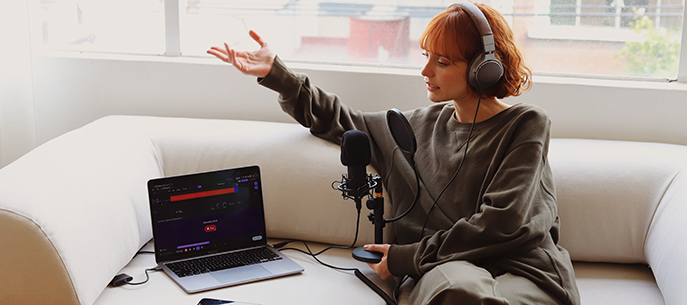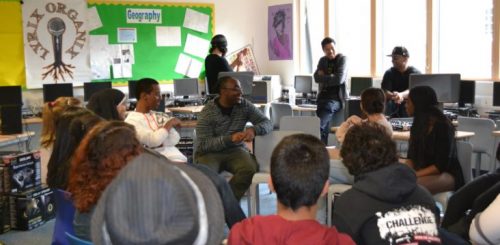
Podcasting 101: Podcast Terms You Need to Know
June 16, 2023Are you ready to take the leap and create your own podcast? The potential is endless, allowing you to create a show around any topic, format, and publishing schedule. But just like branching out into any other form of media, knowledge is power. And while we’re sure you’re super excited to get started, you’ll want to understand a few important podcast terms before creating your first episode.
To help you get started, we’ve made it easy for you by putting the most important vocabulary all in one place. Let’s create, collaborate, and connect together through the power of podcasting. Get ready to unleash your inner storyteller with these podcast terms!
16 Podcast Terms to Know Before Getting Started
Since you’re new to the wonderful world of podcasting, you’ll need to brush up on your vocabulary before jumping in and creating your masterpiece. Fortunately, these podcast terms are pretty easy to learn and will help you communicate with your collaborators, especially during the editing process.
1. Bit Depth
When you’re creating the perfect podcast, you’ll need to select the bit depth before you start recording. The bit depth determines the overall quality of your podcast. There are a few different bit depths to choose from, including 16, 24, and 32. Every audio sample you record will have its own bit depth.
This part can get a little complicated, but you don’t need to know too much about how it works to use the right bit depth. Just know that most podcasters set their recording at 16-bit for spoken word content.
2. Bit Rates
You’ll measure your bit rate using kilobits per second (Kbps). Every second of any audio file takes up a specific amount of kilobits of data, and the bit rate will tell you how much data is in each second.
You’ll need to know the Kbps when you convert your podcast from WAV to MP3 so your listeners can hear your story! Just keep in mind that higher bit rates will increase the file size, so make sure you find the sweet spot of size vs. quality when converting your podcast.
3. Clipping
Clipping is one of the podcast terms that’s also used by music-makers when they’re recording audio tracks. As you record your podcast, you’ll see a waveform on the screen that acts as a visual representation of the volume levels in your audio.
Clipping happens when the audio is too loud and the waveform spikes to the edge of your recording window. When clipping happens, it can cause huge problems in audio recording, so make sure you keep your volume levels nice and balanced.
4. Compression
Just like clipping, compression is another podcasting term that relates to music-making. When you add compression to your audio recording, it’ll help you balance out the volume by bringing the loudest and softest sounds together for a crystal clear sound.
If you’re using Soundtrap for Education, you’ll be able to find compression in the effects list that allows you to apply compression while you’re recording. This way, you won’t need to do it when mastering your podcast!
5. Condenser Microphone
There are many types of microphones to choose from these days, but condenser and dynamic microphones are the most common. A condenser microphone is more sensitive than a dynamic microphone because it uses its own power source. Most people use condenser microphones when recording vocalists and actors, but some podcasters also use them when they can record in a quiet environment.
6. Digital Audio Workstation (DAW)
You’ve probably heard this podcast term before, but we’ll give you a little refresher. A Digital Audio Workstation, also known as a DAW, is the software you’ll use to create and edit your podcast. There are plenty of options to choose from, but Soundtrap for Education is the most popular option for students and educators because it’s made for learners to create, collaborate, and connect with one another.
With a DAW like Soundtrap for Education, there’s no need for fancy equipment because you can use any mobile device to become a stellar storyteller! Also, you can collaborate with peers or even interview experts within Soundtrap, so telling your story is easier than ever.
7. Directories
A directory is where listeners can tune into your show. There are many different podcast directories, but many people that use Soundtrap for Education choose Spotify because you can upload your creation directly from the DAW to the podcast directory. Then, listeners from around the world can download and subscribe to your podcast.
8. Dynamic Microphone
In addition to condenser microphones, a dynamic microphone is another popular option for podcasters. Dynamic microphones need to be plugged in since they don’t have their own power supply. Many podcasters like to use dynamic microphones because they’re more durable than other options. Dynamic microphones are also less sensitive than condenser microphones, making them ideal for podcast recording in noisy environments.
9. Dynamic Range
Without getting too technical, the term “dynamic range” refers to the different volume levels inside a piece of audio. Music makers often use this term, but in podcasting, the dynamic range should stay the same throughout your entire audio recording.
10. Equalization (EQ)
Equalization, commonly referred to as EQ, is a process that allows podcasters to increase or decrease the frequencies within the audio recording. When you’re editing your podcast, you might run into an issue where you hear some extraneous background noise as you increase the volume of your audio. By adjusting the EQ, you can get rid of this nasty sound for crystal-clear audio!
11. Gain
Although gain relates to your volume, it’s quite different. Essentially, adjusting your gain levels will make your microphone more or less sensitive. While gain settings control how your microphone picks up audio, the volume settings control what listeners hear through speakers or earphones.
When it comes to podcasting terms, gain is one of the most important because you’ll need to adjust it before every recording for the best results. However, you can also change your gain levels during the recording so speakers don’t sound too loud or quiet.
12. Mix Down
Your mix down is your audio file after you’re finished mixing and mastering your podcast. In case you weren’t aware, mixing a podcast is when you add cool sound effects, intros, outros, and other important edits before mastering your podcast. Then, during the mastering process, you’ll make a few final adjustments to ensure your mix-down is ready for distribution!
13. Peaking
As you record your podcast, you’ll be able to see the sound in “peaks” and “troughs” on the screen. The top of the waveform is the peak, which is the loudest part of the audio recording.
Meanwhile, the trough is the bottom of the waveform and the quietest part of the recording. Peaking happens when your volume goes too high because of a loud noise, such as a sneeze or excited laughter.
14. Stereo
Stereo audio happens when the audio splits across the left and right channels. If there’s audio coming out of the left channel, listeners will hear the audio from their left speaker, and if there’s sound coming from the right channel, they’ll hear it in the right speaker.
If you want to create a magical sonic experience for your listeners, try experimenting with stereo audio so your listeners have a vivid image of your scene. This is an excellent tool if you’re a podcaster that likes to tell cinematic stories!
15. Timeshifting
When it comes to podcasting terms, this one’s pretty simple. Timeshifting is the act of recording and storing data so that you can read or listen to it later. Podcasting is a prime example of timeshifting because it isn’t a live radio broadcast. You’re simply creating the podcast and uploading it at a later date for your audience.
16. WAV File
Another common podcast term is WAV file. A WAV file is your podcast recording in its original state. All podcasts exist as WAV files as you record and edit each episode. When it’s time to upload your podcast, you’ll export it into a smaller MP3 file. The quality may change slightly when you convert your WAV file, but any changes should be imperceptible to your listeners.
Put These Podcast Terms to Use with Soundtrap for Education
Soundtrap for Education is the ultimate audio production platform for students, teachers, or even aspiring podcasters to create and edit audio recordings. Users can easily tap into their artistic side with this intuitive audio platform, plus use its advanced cloud technology to collaborate with guests or co-hosts at any time or place.
Soundtrap is even perfect for creating podcasts in a classroom setting, as part of any modern-day curriculum. With Soundtrap for Education, students can flex their creativity and work together to create their own audio programming in a safe, teacher-moderated environment.
For new users, the platform comes equipped with a robust resource portal and detailed tutorials to help you get the most out of your podcasting experience. If you’re ready to enhance your final product and reach your podcasting goals, our intuitive cloud-based audio production platform will get you there. Just click to get started today with Soundtrap for Education!
 EDU Portal
EDU Portal


